Barrington Tops National Park
Overview
Immerse yourself in the World Heritage-listed Gondwana Rainforests of Barrington Tops National Park. Easy walks, overnight hikes, great picnic, fishing and camping spots await.
Read more about Barrington Tops National Park
The rainforests of Barrington Tops National Park are of international significance, forming part of the Gondwana Rainforests of Australia World Heritage Area. Carved out of ancient volcanic flows, the park rises from near sea level to over 1500m and protects one of the largest temperate rainforests in mainland Australia, along with a host of diverse habitats and wide range of birds and animals.
The park is a bushwalker’s paradise, with an excellent walking track network that includes short and easy walks to more difficult overnight hikes, with plenty of sites to set up bush camping for the evening.
For those visiting for the day, there are lots of picnic and barbecue areas to enjoy, cycling trails to be explored and views from the park’s lookouts that need to be seen to be believed. Fishing is a popular activity in the park between October and May; you might catch a rainbow or brown trout.
If you're planning to visit the area, it's also a good idea to find out more about Barrington Tops State Conservation Area.
Local alerts
For the latest updates on fires, closures and other alerts in this area, see https://www.nationalparks.nsw.gov.au/visit-a-park/parks/barrington-tops-national-park/local-alerts
Map

Map

Map

Map

Map legend

Contact
- in the North Coast and Country NSW regions
Barrington Tops National Park is always open but may have to close at times due to poor weather or fire danger.
-
-
Gloucester office
02 6538 5300
Contact hours: Monday to Friday, 8.30am to 4.30pm. - 59 Church Street, Gloucester NSW 2422
-
Email: npws.barringtontops@environment.nsw.gov.au
-
Gloucester office
-
-
Scone office
02 6540 2300
Contact hours: Monday to Friday, 8.30am to 4.30pm. - 19 Hayes Street, Scone NSW 2337
-
Email: npws.barringtontops@environment.nsw.gov.au
-
Scone office
Visitor info
All the practical information you need to know about Barrington Tops National Park.
Getting there and parking
Get driving directions
Southern Barrington Tops:
- From Dungog, take Chichester Dam Road for about 10km before turning left on Salisbury Road.
- After about 27km, you'll reach the Lagoon Pinch to Williams River precinct of the park.
Eastern Barrington Tops:
- From Gloucester, take Bucketts Way before turning right onto Gloucester Tops Road.
- After about 30km, you’ll reach the Gloucester River precinct of the park, and further on you’ll find the Gloucester Tops precinct.
Northern Barrington Tops:
From Gloucester:
- Take Thunderbolts Way, which becomes Scone Road and Barrington Tops Forest Road.
- After about 45km, you'll reach Cobark picnic area.
- Continue on for other sites within Polblue and Devils Hole precinct of the park.
From Scone:
- Take Gundy Road, then Hunter Road to Moonan Flat.
- Just past Moonan Flat turn right onto Moonan Brook Road.
- After about 2km, turn left onto Barrington Tops Forest Road.
- You can reach the Barrington Tops precinct by turning left onto Barrington trail south from Barrington Tops Forest Road.
Please note: The condition of the gravel roads in Barrington Tops National Park can vary depending on weather and level of use. This includes Barrington Tops Forest Road, which at times can be corrugated with potholes.
Be prepared for variable road conditions at all times, and drive carefully according to conditions (this includes reducing speed).
For more information about road conditions in the area, contact Gloucester Visitor Information Centre on 1800 802 692, the Gloucester office on (02) 6538 5300, the Scone Visitor Information Centre on (02) 6540 1300, or the Scone office on (02) 6540 2300.
Parking Show more
- Cobark Park picnic area See on map
- Edwards Swamp walking track See on map
- Gloucester Falls picnic area See on map
- Gloucester Tops picnic area See on map
- Honeysuckle picnic area See on map
- Junction Pools campground See on map
- Little Murray campground See on map
By bike
Check out the Bicycle information for NSW website for more information.
By public transport
For information about public transport options, visit the NSW Country Transport website.
Best times to visit
There are lots of great things waiting for you in Barrington Tops National Park. Here are some of the highlights.
Autumn
Take to the park's walking tracks to make the most of cooler and drier daytime weather.
Spring
Look out for ground orchids and other wildflowers along the Polblue Swamp walking track.
Summer
Look out for the eastern water dragon basking on rocks around the streams.
Facilities
Toilets Show more
- Aeroplane Hill walking track
- Devils Hole lookout walk and picnic area
- Edwards Swamp walking track
- Gloucester Falls picnic area
- Gloucester River campground and picnic area
- Honeysuckle Forest track
- Honeysuckle picnic area
- Jerusalem Creek picnic area
- Junction Pools campground
- Little Murray campground
- Polblue campground and picnic area
- Williams River picnic area
- Wombat Creek campground
Picnic tables Show more
- Cobark Park picnic area
- Devils Hole lookout walk and picnic area
- Gloucester Falls picnic area
- Gloucester River campground and picnic area
- Gloucester Tops picnic area
- Honeysuckle Forest track
- Honeysuckle picnic area
- Jerusalem Creek picnic area
- Lagoon Pinch picnic area
- Little Murray campground
- Polblue campground and picnic area
- Williams River picnic area
Barbecue facilities Show more
Maps and downloads
Prohibited
Pets
Pets and domestic animals (other than certified assistance animals) are not permitted. Find out which regional parks allow dog walking and see the pets in parks policy for more information.
Smoking
NSW national parks are no smoking areas.
Nearby towns
Dungog (20 km)
Dungog is a country town with character, backed by magnificent rolling hills, national parks and state forests. It's in the heart of dairy and beef cattle country.
Gloucester (39 km)
Famous for gold deposits and the bushranger Captain Thunderbolt, Gloucester is located in the north Hunter region, east of Barrington Tops. The nearby state forests and national parks are ideal for walking, camping and outdoor adventure sports.
Scone (72 km)
Nestled in the picturesque Upper Hunter, Scone is known as the horse capital of Australia.
Learn more
Barrington Tops National Park is a special place. Here are just some of the reasons why:
World Heritage-listed rainforests

The rainforests in Barrington Tops National Park are part of the Gondwana Rainforests of Australia World Heritage Area; the most extensive strip of diverse rainforest anywhere on earth. The World Heritage Area is a direct window into the past and the future, providing a link to the ancient pre-human world and a stunning and irreplaceable record of life on our planet. You can explore the rainforest on one of the park's many walking tracks, like the Honeysuckle Forest track, the Rocky Crossing walk or the Antarctic Beech Forest track. Listen out for the lyrebird whose mimicking calls ring out through the rainforest.
- Antarctic Beech Forest walking track Antarctic Beech Forest walking track offers rainforest, cascades, scenic views, and birdwatching in Barrington Tops National Park, near Gloucester.
- Careys Peak walking track Easy Careys Peak walking track offers picnicking, scenic views, birdwatching, and historic heritage in the sub-alpine region of Barrington National Park, near Scone.
- Cobark Park picnic area Take a break at Cobark Park picnic area to plan your adventures in the plateau region of Barrington Tops National Park—1 hour from Gloucester.
An ancient landscape

Barrington Tops National Park and the adjoining State Conservation Area are the traditional lands of Biripi, Worimi, Guringai, Geawegal and Wonaruah People. The rainforests of Barrington Tops offered a wealth of resources for Aboriginal people, including many edible fruits, like the native cherry, lilly pilly and figs. Today, the history of Aboriginal people in Barrington Tops is recorded in oral history and in the presence of Aboriginal sites. Barrington Tops National Park protects ancient campsites, scarred trees and sacred ceremonial places.
A dramatic wilderness

Most of Barrington Tops National Park is declared wilderness; large, natural areas of land that, together with their native plants and animal communities, remain essentially unchanged by modern human activity. Wilderness areas in NSW represent the largest, most pristine natural areas within NSW - the last of Australia's wild and untamed places. The edges of the wilderness area of Barrington Tops are easily accessible; some of the most spectacular views in the park are from Careys Peak and Devils Hole and Thunderbolts lookouts. You'll notice the varied textures of the forest below you, with the ranges of the Barrington Wilderness running east and south from the plateau like the fingers of an outstretched hand.
- Barrington trail Take the challenge of the Barrington trail, a 4WD trail in Barrington Tops National Park. Open between October and May every year, plan your 4WD camping holiday now.
- Gloucester Tops circuit Walk through snow gum woodland and ancient rainforest to lookouts and waterfalls, along the Gloucester Tops circuit. This 8km loop combines 3 popular and scenic walks in Barrington Tops National Park.
- Majestic Barrington mountain bike tours Enjoy spectacular scenery as you cycle through Barrington Tops National Park and beyond on this supported mountain bike tour with Aussie Bike or Hike, near Gloucester.
- Rocky Crossing walk Rocky Crossing walk along Williams River offers scenic rainforest views, wildlife and birdwatching on a long easy track in Barrington Tops National Park, near Dungog.
Plants and animals protected in this park
Animals
-

Superb lyrebird (Menura novaehollandiae)
With a complex mimicking call and an elaborate courtship dance to match, the superb lyrebird is one of the most spectacular Australian animals. A bird watching must-see, the superb lyrebird can be found in rainforests and wet woodlands across eastern NSW and Victoria.
-

Swamp wallaby (Wallabia bicolor)
The swamp wallaby, also known as the black wallaby or black pademelon, lives in the dense understorey of rainforests, woodlands and dry sclerophyll forest along eastern Australia. This unique Australian macropod has a dark black-grey coat with a distinctive light-coloured cheek stripe.
-

Bare-nosed wombat (Vombatus ursinus)
A large, squat marsupial, the Australian bare-nosed wombat is a burrowing mammal found in coastal forests and mountain ranges across NSW and Victoria. The only other remaining species of wombat in NSW, the endangered southern hairy-nosed wombat, was considered extinct until relatively recently.
-

Australian brush turkey (Alectura lathami)
The Australian brush turkey, also known as bush or scrub turkey, can be found in rainforests along eastern NSW. With a striking red head, blue-black plumage and booming call, these distinctive Australian birds are easy to spot while bird watching in several NSW national parks.
-

Common ringtail possum (Pseudocheirus peregrinus)
Commonly found in forests, woodlands and leafy gardens across eastern NSW, the Australian ringtail possum is a tree-dwelling marsupial. With a powerful tail perfectly adapted to grasp objects, it forages in trees for eucalypt leaves, flowers and fruit.
-

Rufous scrub-bird (Atrichornis rufescens)
The vulnerable rufous scrub-bird is a small, ground-foraging bird that lives only in isolated rainforest areas of south-eastern Australia.
Environments in this park
Education resources (1)
What we're doing
Barrington Tops National Park has management strategies in place to protect and conserve the values of this park. View the detailed park and fire management documents. Here is just some of the work we’re doing to conserve these values:
Managing weeds, pest animals and other threats
Pests and weeds have a significant impact to the ecosystems within Barrington Tops National Park. Risk assessments for new and emerging weeds are carried out as an ongoing initiative within the park. Phytophthora cinnamomi is a root-rot water mould which is a major threat to park biodiversity which is being managed with the establishment of a quarantine zone to prevent further spread. Pest management of foxes and wild dogs is an important part of the work NPWS does to protect the integrity of biodiversity which exists within Barrington Tops National Park, as well as adjoining agricultural enterprises.
Exploring World Heritage
An important part of the Gondwana Rainforests of Australia World Heritage Area, the rainforests of Barrington Tops National Park are of international significance. Signage updates, both directional and designating the park’s World Heritage status, are ongoing. NPWS works alongside local Aboriginal communities in interpreting the park’s Aboriginal cultural heritage, and engages park neighbours and the wider community wherever possible.
Managing fire
NSW is one of the most bushfire prone areas in the world as a result of our climate, weather systems, vegetation and the rugged terrain. NPWS is committed to maintaining natural and cultural heritage values and minimising the likelihood and impact of bushfires via a strategic program of fire research, fire planning, hazard reduction, highly trained rapid response firefighting crews and community alerts.

